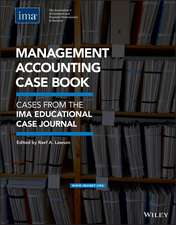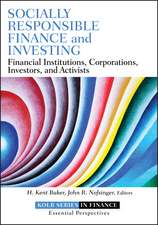Commodity Derivatives – Markets and Applications, Second Edition: The Wiley Finance Series
Autor NC Schofielden Limba Engleză Hardback – 26 mai 2021
Din seria The Wiley Finance Series
- 20%
 Preț: 440.31 lei
Preț: 440.31 lei - 20%
 Preț: 429.66 lei
Preț: 429.66 lei -
 Preț: 220.23 lei
Preț: 220.23 lei -
 Preț: 344.21 lei
Preț: 344.21 lei - 20%
 Preț: 474.95 lei
Preț: 474.95 lei - 20%
 Preț: 507.62 lei
Preț: 507.62 lei -
 Preț: 340.84 lei
Preț: 340.84 lei - 20%
 Preț: 443.14 lei
Preț: 443.14 lei - 8%
 Preț: 489.15 lei
Preț: 489.15 lei -
 Preț: 427.39 lei
Preț: 427.39 lei - 24%
 Preț: 573.27 lei
Preț: 573.27 lei - 20%
 Preț: 515.22 lei
Preț: 515.22 lei -
 Preț: 432.04 lei
Preț: 432.04 lei - 20%
 Preț: 432.77 lei
Preț: 432.77 lei -
 Preț: 274.90 lei
Preț: 274.90 lei -
 Preț: 363.83 lei
Preț: 363.83 lei - 20%
 Preț: 384.23 lei
Preț: 384.23 lei -
 Preț: 359.16 lei
Preț: 359.16 lei - 8%
 Preț: 532.04 lei
Preț: 532.04 lei -
 Preț: 361.14 lei
Preț: 361.14 lei -
 Preț: 441.70 lei
Preț: 441.70 lei - 8%
 Preț: 381.87 lei
Preț: 381.87 lei -
 Preț: 444.58 lei
Preț: 444.58 lei -
 Preț: 195.81 lei
Preț: 195.81 lei - 20%
 Preț: 508.37 lei
Preț: 508.37 lei - 20%
 Preț: 476.30 lei
Preț: 476.30 lei - 20%
 Preț: 444.01 lei
Preț: 444.01 lei - 8%
 Preț: 340.90 lei
Preț: 340.90 lei - 20%
 Preț: 429.01 lei
Preț: 429.01 lei - 24%
 Preț: 682.97 lei
Preț: 682.97 lei - 20%
 Preț: 482.01 lei
Preț: 482.01 lei - 20%
 Preț: 488.31 lei
Preț: 488.31 lei - 9%
 Preț: 1075.80 lei
Preț: 1075.80 lei - 9%
 Preț: 969.57 lei
Preț: 969.57 lei - 9%
 Preț: 745.28 lei
Preț: 745.28 lei - 8%
 Preț: 555.63 lei
Preț: 555.63 lei - 9%
 Preț: 767.24 lei
Preț: 767.24 lei - 8%
 Preț: 632.63 lei
Preț: 632.63 lei - 9%
 Preț: 789.52 lei
Preț: 789.52 lei - 9%
 Preț: 807.09 lei
Preț: 807.09 lei - 9%
 Preț: 706.01 lei
Preț: 706.01 lei - 8%
 Preț: 553.17 lei
Preț: 553.17 lei - 8%
 Preț: 615.85 lei
Preț: 615.85 lei - 9%
 Preț: 719.75 lei
Preț: 719.75 lei - 9%
 Preț: 888.44 lei
Preț: 888.44 lei - 9%
 Preț: 755.88 lei
Preț: 755.88 lei - 8%
 Preț: 708.98 lei
Preț: 708.98 lei - 9%
 Preț: 835.76 lei
Preț: 835.76 lei - 9%
 Preț: 961.77 lei
Preț: 961.77 lei
Preț: 466.32 lei
Preț vechi: 582.90 lei
-20% Nou
Puncte Express: 699
Preț estimativ în valută:
89.23€ • 93.16$ • 73.85£
89.23€ • 93.16$ • 73.85£
Carte disponibilă
Livrare economică 15-29 martie
Livrare express 01-07 martie pentru 54.84 lei
Preluare comenzi: 021 569.72.76
Specificații
ISBN-13: 9781119349105
ISBN-10: 1119349109
Pagini: 544
Dimensiuni: 177 x 247 x 37 mm
Greutate: 1.16 kg
Ediția:2nd Edition
Editura: Wiley
Seria The Wiley Finance Series
Locul publicării:Chichester, United Kingdom
ISBN-10: 1119349109
Pagini: 544
Dimensiuni: 177 x 247 x 37 mm
Greutate: 1.16 kg
Ediția:2nd Edition
Editura: Wiley
Seria The Wiley Finance Series
Locul publicării:Chichester, United Kingdom
Public țintă
The primary market will be: commodity and derivatives traders, analysts, risk managers.The secondary market will be: students, academics and the intern intake in large financial institutions.
Notă biografică
Neil Schofield is the Principal of FMT Ltd, a UK-based firm offering training services in treasury, derivatives, capital markets, and risk management to financial institutions, central banks, and corporations worldwide. From 2001 to 2008 he was Global Head of Financial Markets Training at Barclays Investment Bank.
Cuprins
Preface xi Chapter 1 Fundamentals of Commodities and Derivatives 1 1.1 Market overview 2 1.2 Market participants 3 1.3 Traded versus non-traded commodities 6 1.4 Forward contracts 8 1.5 Futures 8 1.6 Swaps 10 1.7 Options 11 1.8 Exotic options 14 Chapter 2 Derivative Valuation 18 2.1 Asset characteristics 18 2.2 Commodity prices and the economic cycle 18 2.3 Principles of commodity valuation 19 2.4 Forward price curves 21 2.5 Commodity swap valuation 32 2.6 Principles of option valuation 39 2.7 Measures of option risk management 44 Chapter 3 Risk Management Principles 58 3.1 Defining risk 58 3.2 Commodity market participants - the time dimension 60 3.3 Hedging corporate risk exposures 61 3.4 A framework for analysing corporate risk 62 3.5 Hedging customer exposures 63 3.6 Trading risk management 66 Chapter 4 Gold 76 4.1 The market for gold 76 4.2 Gold price drivers 81 4.3 The gold leasing and deposit market 91 4.4 Hedging 96 4.5 Trading gold 106 4.6 Yield enhancement 111 4.7 Summary 112 Chapter 5 Base Metals 114 5.1 Overview of base metal production 114 5.2 The copper lifecycle 115 5.3 Aluminium 119 5.4 The Steel market 120 5.5 The London Metal Exchange 122 5.6 Base metal price drivers 130 5.7 Electric Vehicles 133 5.8 Structure of market prices 134 5.9 Hedges for aluminium consumers in the automotive sector 139 5.10 Summary 157 Chapter 6 Crude Oil 159 6.1 Overview of energy markets 159 6.2 The value of crude oil 159 6.3 An overview of the physical supply chain 163 6.4 Refining crude oil 165 6.5 The demand for and supply of crude oil 172 6.6 Price drivers 179 6.7 The price of crude oil 189 6.8 Trading crude oil and refined products 195 Notes 209 6.9 Managing price risk along the supply chain 212 Chapter 7 Natural Gas 237 7.1 Formation of natural gas 237 7.2 Measuring natural gas 238 7.3 The physical supply chain 238 7.4 Deregulation and re-regulation 242 7.5 The demand for and supply of natural gas 245 7.6 Natural gas prices 250 7.7 Natural gas price drivers 257 7.8 Trading natural gas 260 7.9 Natural gas derivatives 263 Chapter 8 Electricity 280 8.1 What is electricity? 280 8.2 The physical supply chain 283 8.3 Market structure and regulation 285 8.4 Price drivers of electricity 291 8.5 Trading electricity - an overview 301 8.6 Electricity derivatives 313 Chapter 9 Plastics 332 9.1 The chemistry of plastic 332 9.2 The production of plastic 333 9.3 Monomer production 334 9.4 Polymerisation 334 9.5 Applications of plastics 335 9.6 Summary of the plastics supply chain 336 9.7 Price determination 336 9.8 Plastic price drivers 337 9.9 Forwards and swaps 338 9.10 Option strategies 340 Chapter 10 Bulk Commodities 341 10.1 The basics of coal 341 10.2 The demand for and supply of coal 343 10.3 Coal - the physical supply chain 346 10.4 Coal derivatives 349 10.5 Iron ore 353 10.6 Freight markets - the fundamentals 355 Chapter 11 Climate and Weather 368 11.1 The science of climate change 368 11.2 The consequences of climate change 371 11.3 The argument against climate change 372 11.4 History of human action against climate change 373 11.5 Price drivers of emissions markets 376 11.6 EU Emission Trading System 379 11.7 Emission derivatives 384 11.8 Weather derivatives 388 Chapter 12 Agriculture 394 12.1 Agricultural markets 394 12.2 Definitions 394 12.3 Agricultural products 395 12.4 Soft commodities 403 12.5 Ethanol 409 12.6 Price drivers 412 12.7 Exchange traded agricultural and ethanol derivatives 421 12.8 Over-the-counter agricultural derivatives 426 Chapter 13 Commodity-Linked Financing 433 13.1 The financing need 433 13.2 Project finance 437 13.3 Working capital and the asset conversion cycle 440 13.4 Longer-term debt funding solutions 454 Chapter 14 Commodity Investing 463 14.1 Commodity investors 463 14.2 Preferred instruments 465 14.3 Market size 465 14.4 Rationale for investing in commodities 466 14.5 Commodity indices 469 14.6 Total Return Swaps 478 14.7 Exchange traded products (ETPs) 481 14.8 Structured products 487 Glossary 499 Bibliography 507 Biography 510 Index 511















